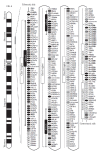HLA Immune Function Genes in Autism
- PMID: 22928105
- PMCID: PMC3420779
- DOI: 10.1155/2012/959073
HLA Immune Function Genes in Autism
Abstract
The human leukocyte antigen (HLA) genes on chromosome 6 are instrumental in many innate and adaptive immune responses. The HLA genes/haplotypes can also be involved in immune dysfunction and autoimmune diseases. It is now becoming apparent that many of the non-antigen-presenting HLA genes make significant contributions to autoimmune diseases. Interestingly, it has been reported that autism subjects often have associations with HLA genes/haplotypes, suggesting an underlying dysregulation of the immune system mediated by HLA genes. Genetic studies have only succeeded in identifying autism-causing genes in a small number of subjects suggesting that the genome has not been adequately interrogated. Close examination of the HLA region in autism has been relatively ignored, largely due to extraordinary genetic complexity. It is our proposition that genetic polymorphisms in the HLA region, especially in the non-antigen-presenting regions, may be important in the etiology of autism in certain subjects.
Figures

References
-
- Kanner L. Autistic disturbances of affective contact. The Nervous Child. 1943;2(2):217–250.
-
- Volkmar FR, State M, Klin A. Autism and autism spectrum disorders: diagnostic issues for the coming decade. Journal of Child Psychology and Psychiatry and Allied Disciplines. 2009;50(1-2):108–115. - PubMed
-
- Centers for Disease Control and Prevention (CDC) Prevalence of autism spectrum disorders-Autism and developmental disabilities monitoring network, United States, 2006. CDC—Morbidity and Mortality Weekly Report. 2009;58(10):1–20. - PubMed
-
- Altevogt BM, Hanson SL, Leshner AI. Autism and the environment: challenges and opportunities for research. Pediatrics. 2008;121(6):1225–1229. - PubMed
-
- Chess S. Autism in children with congenital rubella. Journal of Autism and Childhood Schizophrenia. 1971;1(1):33–47. - PubMed
Grants and funding
LinkOut - more resources
Full Text Sources
Research Materials

